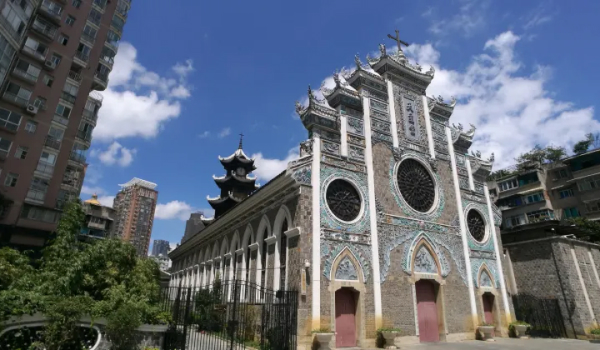
Guiyang is located in central Guizhou province, situated on the east of the Yungui Plateau, and on the north bank of the Nanming River, a branch of the Wu River. The city has an elevation of about 1,100 meters. It has an area of 8,034 square kilometers. "Zhu" is the abbreviation for Guiyang City because it is located in the south of Mount Guishan.
Guizhou Province, known as Qian for short, is situated in the southwest of China.
Guizhou has a total population of 38 million, of which one-third belong to 49 ethnic minorities. These minorities account for 37.8 percent of the province's population. There are 56 ethnic minorities in China. The province, whose capital, Guiyang,is 1,730 kilometers southwest of Beijing, is one of the poorest areas of China. While most Catholics in Guizhou province are ethnic Han Chinese, some of the Catholics are ethnic Miao who mainly live in the rural area. Miao, an ethnic minority group, inhabit southern China and are mostly found in Guangdong, Guangxi, Guizhou, Hubei, Hunan, Sichuan and Yunnan provinces.
On October 15, 1696, the city was made the seat of the Roman Catholic Apostolic Vicariate of Kweichow. This was suppressed in 1715 and restored in 1846. In 1924 it was renamed as the Apostolic Vicariate of Guiyang, and in 1946it was promoted as Archdiocese of Guiyang. In 1999, the open Church merged Anlong, Guiyang and Shiqian dioceses to form Guizhou diocese, which covers the whole province.
Guizhou had 45,000 Catholics before the Communist Party came to power in mainland China in 1949. The Catholic population has since grown to 100,000 after religion enjoyed a revival in the late 1970s. They are served by 70 churches as of now. The church in Qingyan was built in 1863 near where four Chinese Catholics - Martha Wang, John Luo, and two seminarians were beheaded two years earlier. They were beatified in 1919 and canonized in 2000. The town is 30 kilometers from Guiyang, the capital of Guizhou province.
The small town of Qingyan was formed seven centuries ago as a stone-built fortress. It now attracts tourists because of its cultural, historical and religious monuments. Besides the Catholic house of worship, it also features a Protestant church and a dozen Buddhist, Taoist and folk religious temples that were erected over the centuries.
Guizhou has a humid, sub-tropical monsoonal climate with warm winters, mild summers, and unclear seasonal contrasts. It has a mean annual temperature of 14 degrees Celsius - 16 degrees Celsius, and mean annual precipitation of 1,100-1,400 mm. It has more overcast days than any other part of the country, the area around Guiyang averaging 220 cloudy days a year.
In the fields of agriculture and by-products, there are mainly paddy rice, maize, rapeseed, tobacco; and the outputs of tung oil, oil tea, Chinese Tallow, raw lacquer, tea, and traditional Chinese medicinal materials have occupied a predominant position in the domestic market. In the field of industries, priorities are given to the development of iron and steel, coal, metallurgy, chemical, machinery, electricity, cigarette, and papermaking industries.
According to the provincial government, Guizhou's gross domestic product per capita for 2004 was 4,215 yuan (US$617 as of Mai 2010), or a total of 159.2 billion yuan. A report from the official "People's Daily" newspaper said, the number of people living there on less than US$1 a day was2.77 million at the end of 2002, more than one-tenth of the national total for the category. Xiao Wang, a local tour guide, told UCA News that the hilly or rocky terrain covering more than 90 percent of Guizhou has impeded development efforts. The area is safe from natural disasters such as earthquakes and floods but has very changeable weather conditions. There is an old saying that Guizhou "never has three days of sunshine in a row."Since most Catholics here are poor farmers, the diocese survives by renting out Church properties.
The landforms with widely dispersed karst topography in Guizhou Province have created picturesque scenery with grandeur. Places of historic interest and scenic beauty include the Yellow Fruit Tree Waterfall (Huangguoshu Waterfall), the Anshun Water Cave of Dragon Palace, the Gold-Knit Cave, Red Maple Lake, Flower Stream, and the Lesser Seven-Arched Scenic Site, some of which have been listed as cultural relics preservation sites under the state protection.
As a multinational province, the colorful costumes and custom of the ethnic minority groups attract visitors far and wide, for instance, group dance of the Yi people, wine song and bronze drum of the Bouyei people, and festivals like the March 3 Festival (in Chinese lunar calendar), the Torch Festival, and the Dragon Boat Festival, etc.